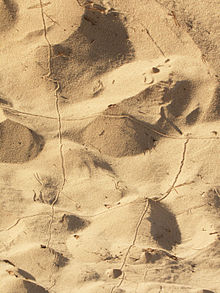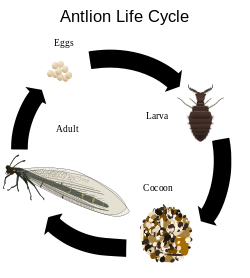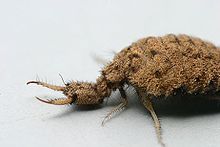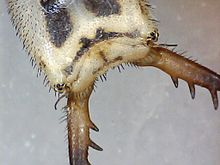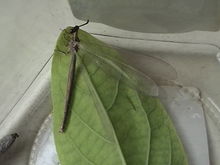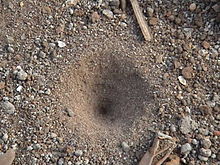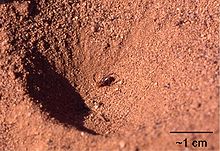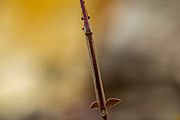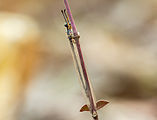
Antlion
Did you know...
SOS Children offer a complete download of this selection for schools for use on schools intranets. Do you want to know about sponsoring? See www.sponsorachild.org.uk
| Antlions Temporal range: 251–0Ma Mesozoic - Recent |
|
|---|---|
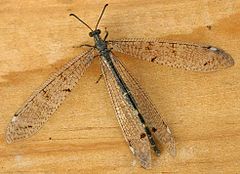 |
|
| Adult Distoleon tetragrammicus | |
| Scientific classification | |
| Kingdom: | Animalia |
| Phylum: | Arthropoda |
| Class: | Insecta |
| Order: | Neuroptera |
| Suborder: | Myrmeleontiformia |
| Superfamily: | Myrmeleontoidea |
| Family: | Myrmeleontidae |
| Subfamilies | |
|
Acanthaclisinae |
|
| Synonyms | |
|
Myrmeleonidae ( lapsus) |
|
Antlions are a group of insects in the family Myrmeleontidae (sometimes misspelled as "Myrmeleonidae"). The most well-known genus is Myrmeleo. There are about 2,000 species. Strictly speaking, the term "antlion" applies to the larval form of the members of this family, but while several languages have their own terms for the adult, there is no widely used word for them in English. Very rarely, the adults are called "antlion lacewings".
The antlion larva is often called "doodlebug" in North America because of the odd winding, spiralling trails it leaves in the sand while looking for a good location to build its trap, as these trails look like someone has doodled in the sand.
Description and ecology
Antlions are worldwide in distribution, most common in arid and sandy habitats. A few species occur in cold- temperate places; a famous example is the European Euroleon nostras, whose scientific name means "our European lion". They can be fairly small to very large Neuroptera (wingspan range of 2–15 cm). The antlion larvae eat small arthropods – mainly ants – while the adults of some species eat small pollen and nectar, while others are predators of small arthropods in the adult stage too. In certain species of Myrmeleontidae, such as Dendroleon pantheormis, the larva, although resembling that of Myrmeleon structurally, makes no pitfall, but seizes passing prey from any nook or crevice in which it shelters.
The adult has two pairs of long, narrow, multi-veined wings in which the apical veins enclose regular oblong spaces, and a long, slender abdomen. Although they greatly resemble dragonflies or damselflies, they belong to an entirely different infraclass among the winged insects. Antlions are easily distinguished from damselflies by their prominent, apically clubbed antennae which are about as long as head and thorax combined. Also, the pattern of wing venation differs, with the very long hypostigmatic cell (behind the fusion point of Sc and R1) being several times as long as wide. They also are very feeble fliers and are normally found fluttering about in the night, in search of a mate. The adult is thus rarely seen in the wild because it is typically active only in the evening. They are highly active in desert regions and are a nuisance. They will deliver a small, mildly painful bite if given the chance to land on someone.
The life cycle of the antlion begins with oviposition ( egg-laying). The female antlion repeatedly taps the sand surface with the tip of her abdomen. She then inserts her abdomen into the sand and lays an egg. The antlion larva is a ferocious-appearing creature with a robust, fusiform body, a very plump abdomen, the thorax bearing three pairs of walking legs. The prothorax forms a slender mobile "neck" for the large, square, flattened head, which bears an enormous pair of sicklelike jaws with several sharp, hollow projections. The jaws are formed by the maxillae and mandibles, which in each pincer enclose a canal for injecting venom between them. Depending on species and where it lives, the larvae will either hide under leaves or pieces of wood, in cracks of rocks, or dig pits in sandy areas. Antlion larvae are unusual among the insects as they lack an anus. All the metabolic waste that is generated during the larval stage is stored and is eventually emitted as meconium near the end of its pupal stage.
The pupal stage of the antlion is quiescent. The larva makes a globular cocoon of sand stuck together with fine silk spun from a slender spinneret at the posterior end of the body. These cocoons may be buried several centimeters deep in the sand. It remains there for one month, until the completion of the transformation into the sexually mature insect, which then emerges from the case, leaving the pupal integument behind, and climbs to the surface. After about 20 minutes the adult's wings are fully opened and it will fly off in search of a mate. The adult is considerably larger than the larva; they exhibit the greatest disparity in size between larva and adult of any type of holometabolous insects, by virtue of the adults having an extremely thin, flimsy exoskeleton - in other words, they have extremely low mass per unit of volume.
Systematics
The closest living relatives of antlions are the owlflies (Ascalaphidae). The extinct Babinskaiidae, known only from fossils, were also very closely related. These three form the most strongly derived lineages of the superfamily Myrmeleontoidea.
The numerous genera and species of antlions are for the largest part assigned to a diversity of subfamilies. A few genera, mostly fossil, are of more uncertain or basal position. The fossil record of antlions is very small by neuropteran standards. However, there are some Mesozoic fossils which attest to the antlions' origin more than 150 million years ago. These were at one time separated as family Palaeoleontidae, but are now usually recognized as the most primitive examples of actual antlions.
The subfamilies, with some notable species and genera also listed, are:
- Acanthaclisinae
- Brachynemurinae
- Dendroleontinae
- Bankisus Navás, 1912 (= Navasius)
- Dendroleon (fossil)
- Dimarinae
- Echthromyrmicinae
- Glenurinae
- Myrmecaelurinae
- Myrmeleontinae
- Euroleon Esben-Petersen, 1918
- Euroleon nostras
- Glenoleon Banks, 1913
- Glenoleon falsus
- Glenoleon pulchellus Australia
- Euroleon Esben-Petersen, 1918
- Nemoleontinae (sometimes in Myrmeleontinae)
- Palparinae (including Araripeneurinae)
- Pseudimarinae
- Stilbopteryginae
Antlions of uncertain systematic position are:
- Palaeoleon (fossil)
- Porrerus
- Samsonileon (fossil)
Etymology
The exact meaning of the name "antlion" is uncertain. It has been thought that it refers to the fact that ants form a large percentage of the prey of the insect, the suffix "lion" merely suggesting destroyer or eater. Perhaps, however, the name as a whole only signifies a large terrestrial biting apterous insect, surpassing ants in size and predatory habits, similar to the concept of the lion being "king of the animals" in European mythology and lore. In any case, the term seems to go back to Antiquity.
In most European languages, at least the larvae are known under the local term corresponding to "antlion":
- Romance languages: e.g. formicaleo ( Medieval Latin), formicaleone (Italian), formiga-leão (Portuguese), formiga león (Galician), formigues lleó (Catalan), fourmilion or fourmis-lion (French), hormiga león (Spanish), leii furnicilor (Romanian)
- Germanic languages: e.g. Ameisenlöwe (German), maurløve (Norwegian), mierenleeuw (Dutch), mierleeu (Afrikaans), myreløve (Danish), myrlejon (Swedish)
- Slavic languages: e.g. mravkolev (Czech), mravkol'v (мравколъв, Bulgarian), mravlji lav (Serbo-Croatian), mrówkolew (Polish), murav'iniy lev (муравьиный лев, Russian)
- Baltic languages: e.g. skudrulauva (Latvian), skruzdžių liūtas (Lithuanian)
- Finnic languages: e.g. muurahaisleijona (Finnish), sipelgalõvi (Estonian)
- Albanian: luani thnegslave Cherokee Native American's word for antlion is Yahoola.
In Hebrew, antlions are called arinamal (ארינמל), in Arabic asad al-naml (أسد النمل), and in Turkish their name is karınca arslanı. These are also literal equivalents of the English name, though at least the last would seem to date to more recent times, being adapted from some European or Near Eastern language.
The scientific name of the type genus Myrmeleo – and thus, the family as a whole – is derived from Ancient Greek léon (λέων, Modern Greek: lión, λιόν) "lion" + mýrmex (μύρμηξ, Modern Greek: myrmígia, μυρμήγκια) "ant", in a literal translation of the names common across Europe.
But in Hungarian – whose progenitor separated from the ancestral Finnic languages in the Urals region the eastern border of Europe – antlions are called hangyaleső, "ant-ambushers". Terms meaning "antlion" are not found as the animals' original names far outside Europe, so it seems that the concept of and words meaning "antlion" were known across Europe by about 500 AD, when the Magyars began their migration to present-day Hungary – and that they at that time already had embraced the concept of and term for "ant-ambusher" so firmly that modern Hungarian is apparently the only language in the whole of Europe and the Mediterranean region whose name for Myrmeleontidae has an etymology different from all others'. It stands to note that one of the first attested occurrences of μυρμηκολέων is a mistranslation of a rarely-used Hebrew term for "lion" in the Septuagint, dating back a few centuries BC. Therefore the "antlion" concept would seem to have spread across Europe from the Mediterranean region during the first few centuries AD, about the time of the decline of the Roman Empire, when cultural exchange between Mediterranean and Northern European peoples was vigorous.
Outside Europe, antlions are sometimes given names that compare their jaws to a bull's horns. In Mandarin, dǎotuìniú (倒退牛, "backward-moving bull"), dìgǔniú (地古牛, "ancient soil-bull") and yǐniú (蚁牛, "ant-bull") are known. In southwestern North America, the colloquial Spanish name is torito ("little bull"). Other names refer to the larvae's behaviour: aMbututu ("hider-and-digger", Xitsonga), undur-undur ("backwards-walker", Malay), kumhar ("potter", Punjabi) or bingundha ("tunnel digger", Sinhala). It is called kuzhi-ana in Malayalam, literally, "Pit elephant". In Brazil, they go by diverse terms with translations such as "little dog of the woods", "little armadillo", and "vulture louse".
In some regions of East Asia, Korea, for example, the antlion are referred to as the "ant demon" (개미귀신) and their traps – are locally known by terms translating approximately as "ant-hell". In Korean, this is gaemi jiog (개미지옥), and the corresponding Japanese word is ari-jigoku (アリジゴク, or 蟻地獄). The term ari-jigoku is also used to describe a situation in which one has fallen into inevitable doom, and must languish while awaiting disaster.
In some languages, there are different names for the larva and the adult. In German, the adults are called Ameisenjungfer (approximately "ant- damselfly"); the Finnish term muurahaiskorento and the Estonian sipelgakiillased mean the same. In Dutch mierenleeuwjuffer ("antlion-damselfly") is sometimes used. In Japanese, the term for the adult animals is usuba-kagerou (ウスバカゲロウ or 薄羽蜉蝣), which means "thin-winged mayfly". In Korea, the adult is known as Myeongju jamjari (명주잠자리), meaning approximately "silken dragonfly". All these terms refer to the habitus and the somewhat clumsy flight of the adult animals, which somewhat resembles the unrelated insects they are compared to.
There are also a number of nicknames for the larvae, most of which have no readily discernible etymology. Apart from the North American "doodlebug", these include "shuntie" and joerie (pronounced "yoory") in South Africa, "devil-devil" in Australia, jampeepee on Antigua and Barbuda, "tambaboy" in Waray-Waray, which is a major dialect in the Eastern Visayas region of the Philippines,"tortee" or "torty" (probably from "tortoise") on St Vincent and the Grenadines, and chanchito in Costa Rica.
Sand pit traps
An average-sized larva digs a pit about 2 inches (5 cm) deep and 3 inches (7.5 cm) wide at the edge. This behaviour has also been observed in a family of flies, the Vermileonidae, whose larvae dig the same sort of pit to feed on ants. Having marked out the chosen site by a circular groove, the antlion larva starts to crawl backwards, using its abdomen as a plough to shovel up the soil. By the aid of one front leg it places consecutive heaps of loosened particles upon its head, then with a smart jerk throws each little pile clear of the scene of operations. Proceeding thus it gradually works its way from the circumference towards the centre. As it slowly moves round and round, the pit gradually gets deeper and deeper, until the slope angle reaches the critical angle of repose (that is, the steepest angle the sand can maintain, where it is on the verge of collapse from slight disturbance). When the pit is completed, the larva settles down at the bottom, buried in the soil with only the jaws projecting above the surface, often in a wide-opened position on either side of the very tip of the cone.
Since the sides of the pit consist of loose sand at its angle of repose, they afford an insecure foothold to any small insects that inadvertently venture over the edge, such as ants. Slipping to the bottom, the prey is immediately seized by the lurking antlion; or if it attempts to scramble up the treacherous walls of the pit, it is speedily checked in its efforts and brought down by showers of loose sand which are thrown at it from below by the larva. By throwing up loose sand from the bottom of the pit, the larva also undermines the sides of the pit, causing them to collapse and bring the prey with them. Thus it does not matter whether the larva actually strikes the prey with the sand showers.
Antlion larvae are capable of capturing and killing a variety of insects and other arthropods, and can even subdue small spiders. The projections in the jaws of the larva are hollow and through this the larva will suck the fluids out of its victim. After the contents are consumed, the dry carcass is flicked out of the pit. The larva readies the pit once again by throwing out collapsed material from the centre, steepening the pit walls to the angle of repose.
Antlions are especially abundant in soft sand beneath trees or under overhanging rocks. Apparently the larvae prefer dry places that are protected from the rain. Eventually the larva attains its maximum size and undergoes metamorphosis. The entire length of time from egg-laying to adulthood may take two or three years due to the uncertainty and irregular nature of its food supply. When it first hatches, the tiny larva specializes in very small insects, but as it grows larger, it constructs larger pits and thus catches larger prey.
